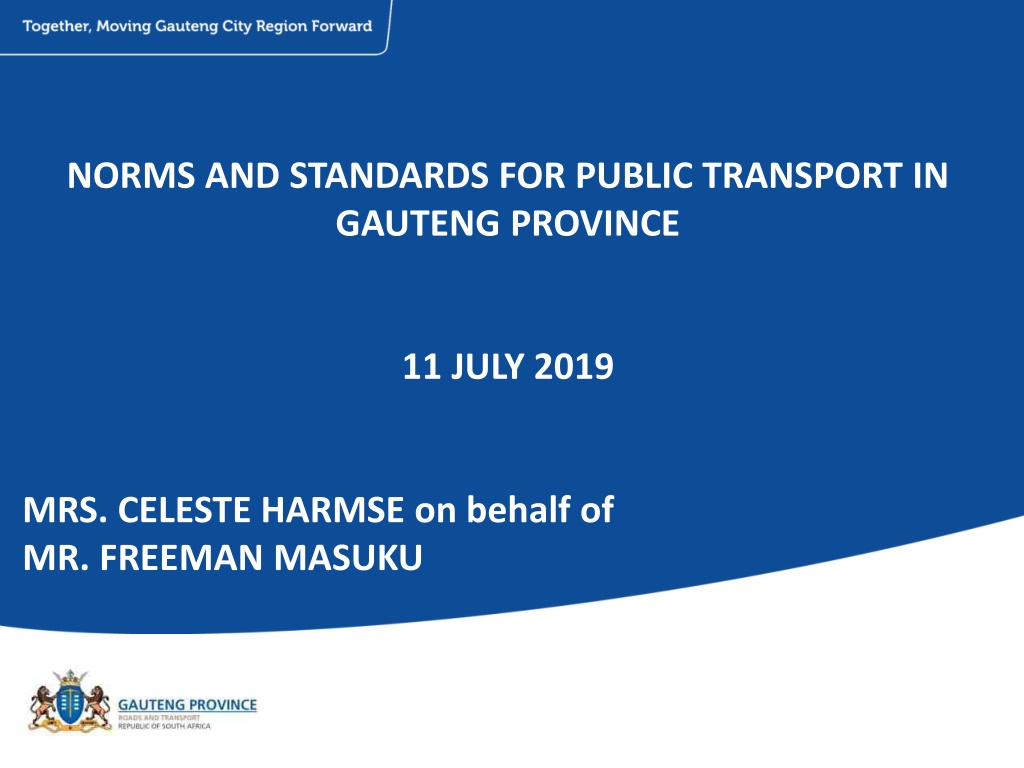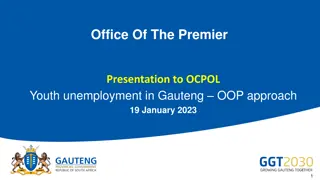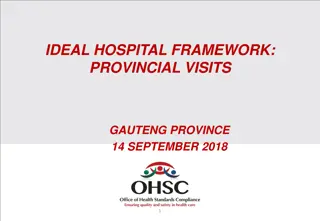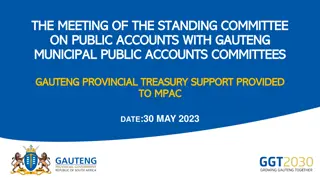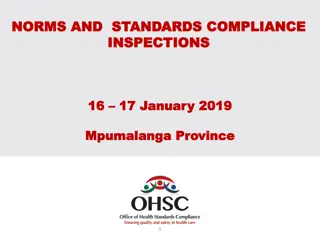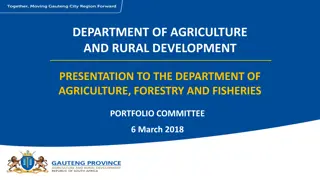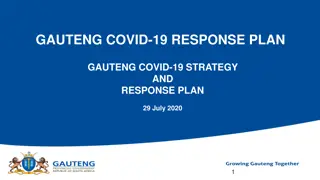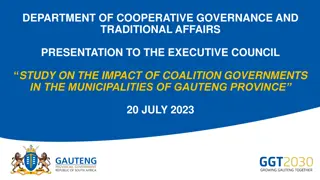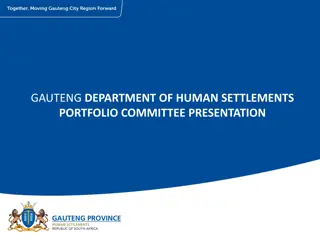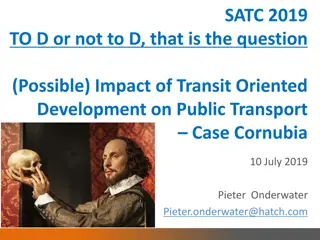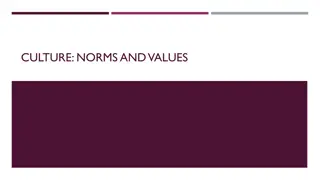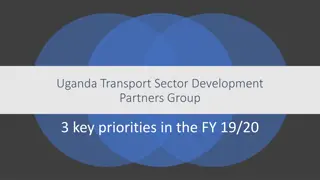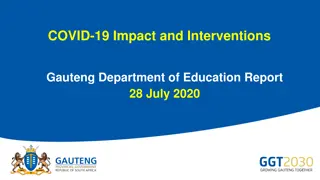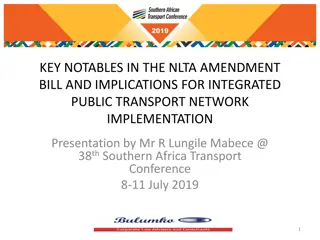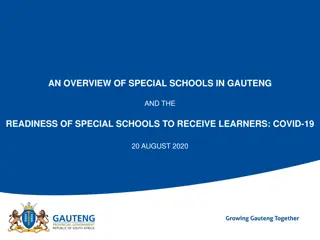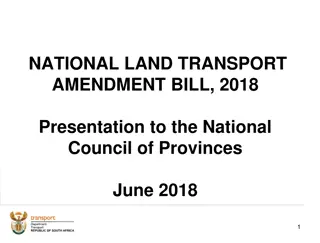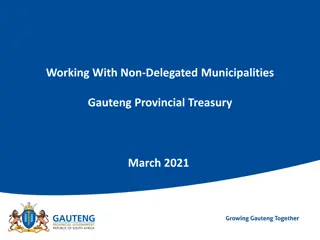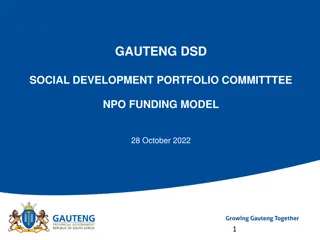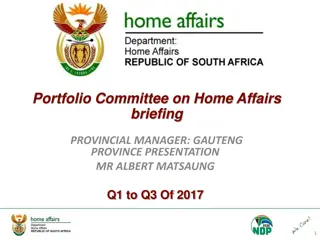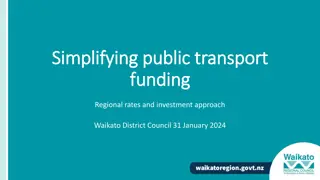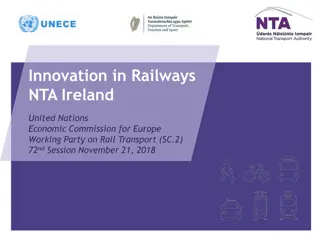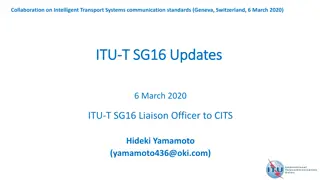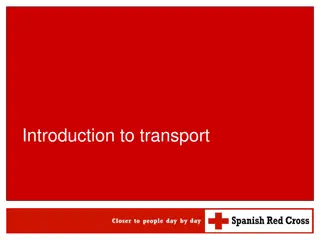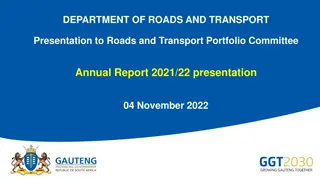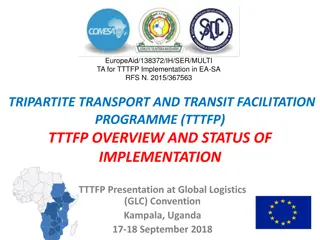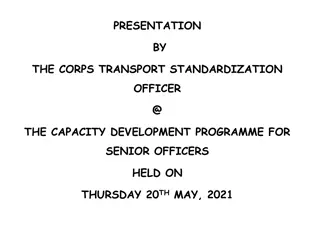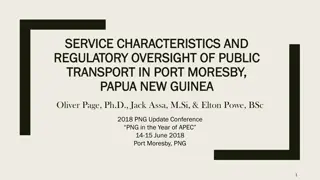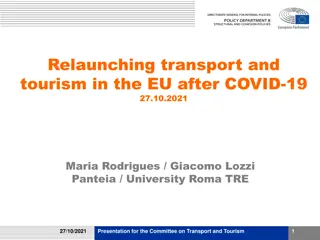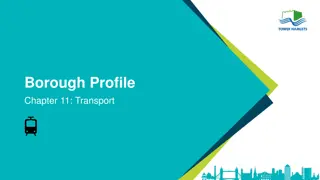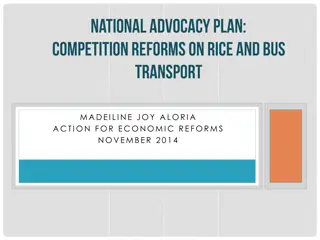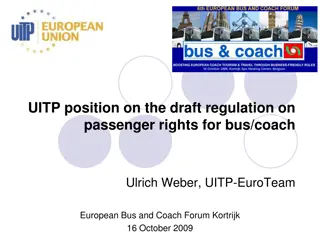Norms and Standards for Public Transport in Gauteng Province - July 2019
This document outlines the norms and standards for public transport in Gauteng Province as of July 2019, covering aspects such as service quality, availability, convenience, comfort, reliability, and more. It addresses the importance of service reliability and its impact on passenger demand, operational efficiency, and user satisfaction. The standards also touch on factors like age of vehicles, noise levels, cleanliness, and roadworthiness testing. Stakeholder engagement, presentation, and compliance with the National Land Transport Act are key focus areas.
Download Presentation

Please find below an Image/Link to download the presentation.
The content on the website is provided AS IS for your information and personal use only. It may not be sold, licensed, or shared on other websites without obtaining consent from the author. Download presentation by click this link. If you encounter any issues during the download, it is possible that the publisher has removed the file from their server.
E N D
Presentation Transcript
NORMS AND STANDARDS FOR PUBLIC TRANSPORT IN GAUTENG PROVINCE 11 JULY 2019 MRS. CELESTE HARMSE on behalf of MR. FREEMAN MASUKU
CONTENT Purpose Background Aspects Considered Norms and Standards Considered Example of Norm Example of Standard Recommended minimums Way Forward
PURPOSE Presentation Stakeholder Engagement
BACKGROUND General National Land Transport Act
ASPECTS CONSIDERED Public transport customer Readable Communicate expectations Local and International Prioritisation Calibration Living Document
NORMS AND STANDARDS CONSIDERED Basic Norm Service Quality Temporal Availability Convenience Comfort Reliability Travel Time
NORMS AND STANDARDS CONSIDERED CONT. Supplementary Norm Public Transport Modes and Vehicles Public Transport Facilities Service Quality Age of the Vehicle Noise Levels Cleanliness Toilet
NORMS AND STANDARDS CONSIDERED CONT. Temperature Testing of Motor Vehicles for Road worthiness Road Worthiness of Vehicle Service reliability Emissions control Standards Measurement of Noise Emitted by Motor Vehicles in Motion Public Transport Noise Levels Noise Levels
EXAMPLE OF NORM Service quality norms: Service Reliability (%) Objective: Service reliability is defined by the extent to which the service runs on time as scheduled. Service reliability affects the amount of time a passenger must wait, and the amount of time spent travelling. Poor service reliability will negatively affect the passenger demand for a service, as well as create operational problems such as vehicle overcrowding and vehicle bunching. Context: A wide variety of factors affect the reliability of a service. Reliability applies to public transport modes. The design user is classified as the potential new public transport user, (abled or disabled) as well as regular users of the public transport mode under consideration. If a high proportion of elderly people use the services provided, an adjustment should be made to the walking distance times. The assumptions made in the LOS section are: The public transport services do not run at frequent intervals. Level of service applies to less than 6 buses/hour. A bus is considered late, when it is 5 min behind the scheduled time. The following LOS descriptions only apply to scheduled services. In congested periods, preference should be given to public transport vehicle. Definitions: Reliability is defined as the percentage of vehicles that adhere to the timetable (Giannopoulos, 1989). A timetable is defined in accordance with the National Land Transport Act (Act 5 of 2009) (The Presidency, Vol. 526, 2009). Performance variable Level of Service A B C D E F Measurement method: The measurement for reliability can be objectively measured in terms of the proportion of times a vehicle arrives at a service point relative the schedule. Measured performance (%) 99 < 99 and 96 < 96 and 93 < 93 and 90 < 90 and 85 < 85 Reliability (%)
EXAMPLE OF NORMS CONT. Service quality norms: Service Reliability (%) Objective: Service reliability is defined by the extent to which the service runs on time as scheduled. Service reliability affects the amount of time a passenger must wait, and the amount of time spent travelling. Poor service reliability will negatively affect the passenger demand for a service, as well as create operational problems such as vehicle overcrowding and vehicle bunching.
EXAMPLE OF NORMS CONT. Service quality norms: Service Reliability (%) Context: A wide variety of factors affect the reliability of a service. Reliability applies to public transport modes. The design user is classified as the potential new public transport user, (abled or disabled) as well as regular users of the public transport mode under consideration. If a high proportion of elderly people use the services provided, an adjustment should be made to the walking distance times. The assumptions made in the LOS section are: The public transport services do not run at frequent intervals. Level of service applies to less than 6 buses/hour. A bus is considered late, when it is 5 min behind the scheduled time. The following LOS descriptions only apply to scheduled services. In congested periods, preference should be given to public transport vehicle.
EXAMPLE OF NORMS CONT. Service quality norms: Service Reliability (%) Definitions: Reliability is defined as the percentage of vehicles that adhere to the timetable (Giannopoulos, 1989). A timetable is defined in accordance with the National Land Transport Act (Act 5 of 2009) (The Presidency, Vol. 526, 2009).
EXAMPLE OF NORMS CONT. Service quality norms: Service Reliability (%) Performance variable Level of Service Measured performance (%) A B C D E F 99 < 99 and 96 < 96 and 93 < 93 and 90 < 90 and 85 < 85 Reliability (%) Measurement method: The measurement for reliability can be objectively measured in terms of the proportion of times a vehicle arrives at a service point relative the schedule.
EXAMPLE OF STANDARDS Service quality standards: SANS10047:2009 The Testing of Motor Vehicles for Road worthiness Context: The norms which this standard applies to are given below: Service convenience; Service reliability; Temporal availability; Travel time; Temperature; and Etc. Definitions: Definitions for the specified road vehicles and school buses are the same as those contained within the respective norms. A category M vehicle is defined as a power driven vehicle having a minimum of four wheels and allows for the transport of passengers (South African National Standard, 2005). Category M2 is a public transport vehicle that has more than 8 seats in addition to the drivers and the vehicles total mass does not exceed 5 tons as well as corresponding to one of the following class vehicle (class I, class II, class III, class A or class B) (South African National Standard, 2005). Category M3 is a public transport vehicle that has more than 8 seats in addition to the drivers and the vehicles total mass exceeds 5 tons as well as corresponding to one of the following class vehicle (class I, class II, class III, class A or class B) (South African National Standard, 2005). Relevant standards also applicable to the relevant norms affected: Relevant standards that affect the norms used in this context are given within section 2 of SANS10047:2009. Another relevant standard that is not mentioned but where reference is given is SANS947:2005 known as vehicle classifications. Any assumptions made: As per relevant national legislation and the prescribed requirements, the mentioned standard will cover all the criteria for roadworthiness (South African National Standard, 2009). Rail Infrastructure and services will be assessed differently and according to a different standard.
EXAMPLE OF STANDARDS CONT. Service quality standards: SANS10047:2009 The Testing of Motor Vehicles for Road worthiness Context: The norms which this standard applies to are given below: Service convenience; Service reliability; Temporal availability; Travel time; Temperature; and Etc.
EXAMPLE OF STANDARDS CONT. Service quality standards: SANS10047:2009 Definitions: Definitions for the specified road vehicles and school buses are the same as those contained within the respective norms. A category M vehicle is defined as a power driven vehicle having a minimum of four wheels and allows for the transport of passengers (South African National Standard, 2005). Category M2 is a public transport vehicle that has more than 8 seats in addition to the drivers and the vehicles total mass does not exceed 5 tons as well as corresponding to one of the following class vehicle (class I, class II, class III, class A or class B) (South African National Standard, 2005). Category M3 is a public transport vehicle that has more than 8 seats in addition to the drivers and the vehicles total mass exceeds 5 tons as well as corresponding to one of the following class vehicle (class I, class II, class III, class A or class B) (South African National Standard, 2005).
EXAMPLE OF STANDARDS CONT. Service quality standards: SANS10047:2009 Relevant standards also applicable to the relevant norms affected: Relevant standards that affect the norms used in this context are given within section 2 of SANS10047:2009. Another relevant standard that is not mentioned but where reference is given is SANS947:2005 known as vehicle classifications.
EXAMPLE OF STANDARDS CONT. Service quality standards: SANS10047:2009 Any assumptions made: As per relevant national legislation and the prescribed requirements, the mentioned standard will cover all the criteria for roadworthiness (South African National Standard, 2009). Rail Infrastructure and services will be assessed differently and according to a different standard.
RECOMMENDED MINIMUMS Norms and Standards Convenience Recommended minimum level C: Peak headway (minutes): 8 and < 13 peak headway 15 and < 20 D: < m2/passenger: 0.60 and 0.45 C: Reliability (%): < 96 and 93 C: Hours of service (hours): < 16 and 12 C: Passenger travel time (minutes): 50 and < 70 C: Temperature < 20 and 18; or > 26 and 27 C: Travel time (minutes): 12 and < 14 C: In-vehicle noise (decibels): > 70 and 75 D: 2 transfers or less with transfer time less than 2 minutes Off- Service comfort Service reliability Temporal availability Travel time Ambient temperature Spatial availability Internal noise level Transfers
WAY FORWARD Questions that still need to be answered: Who will sets the norms and standards? (Transport Authority?) How should compliance with standards, in particular, be transitioned from current levels to prescribed standards? What are the penalties for non-compliance to the standards? Who pays for the implementation of the norms and standards?
END OF PRESENTATION Discussions, Comments, Questions
